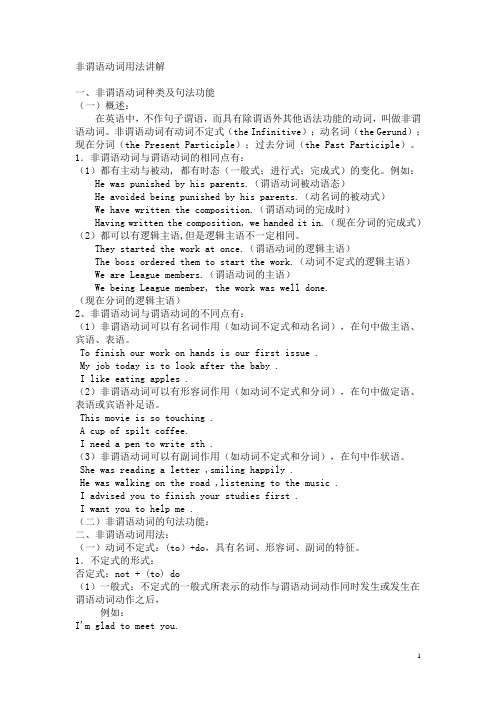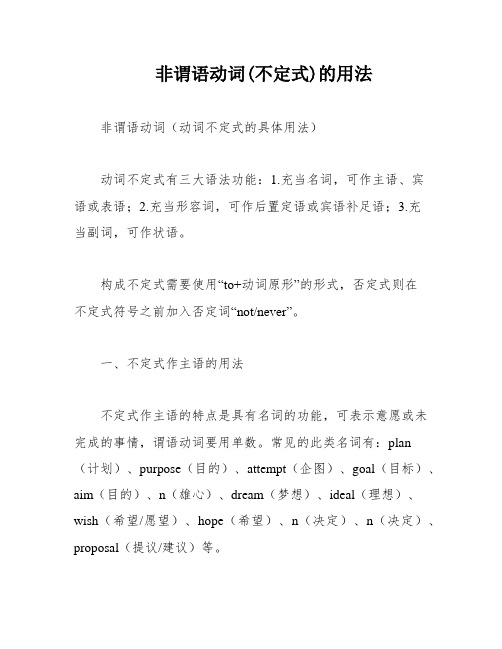动词非谓语形式用法精讲
动词的非谓语形式及其用法详解

动词的非谓语形式及其用法详解动词是语言中最基本的词类之一,它用来表示动作、状态或者存在。
除了常见的谓语形式,动词还有一些非谓语形式,包括动词不定式、动名词和分词。
本文将详细介绍这些非谓语形式及其用法。
一、动词不定式动词不定式是动词的一种非谓语形式,一般由“to + 动词原形”构成。
它有以下几种用法:1. 作目的状语:动词不定式可以在句子中充当目的状语,表示动作的目的或目标。
例:I went to the supermarket to buy some groceries.(我去超市买了些杂货。
)2. 作结果状语:动词不定式可以表示动作的结果。
例:She studied hard to pass the exam.(她努力学习以通过考试。
)3. 作目补:动词不定式可以作为某些动词的宾语补语,用来补充说明宾语的内容或者目的。
例:I want to be a doctor.(我想成为一名医生。
)4. 作形容词定语:动词不定式可以修饰名词,充当形容词。
例:He has a book to read.(他有一本可以阅读的书。
)二、动名词动名词是一种由动词构成的名词,通常以-ing结尾。
它有以下几种用法:1. 作主语:动名词可以作为句子的主语。
例:Swimming is my favorite sport.(游泳是我最喜欢的运动。
)2. 作宾语:动名词可以作为及物动词的宾语。
例:She enjoys reading novels.(她喜欢读小说。
)3. 作介词的宾语或介词短语的一部分:动名词可以跟在介词后面,充当介词的宾语或介词短语的一部分。
例:He is good at cooking.(他擅长做饭。
)三、分词分词是一种由动词构成的非谓语形式,根据其形式和用法的不同,分词可以分为现在分词(ing形式)和过去分词(通常以-ed、-en结尾)。
分词有以下几种用法:1. 作定语:分词可以修饰名词,充当形容词。
例:The broken window needs to be repaired.(这扇破损的窗户需要修理。
非谓语动词的三种形式及用法区别

非谓语动词的三种形式及用法区别一、非谓语动词的三种形式:1. 动词-ing形式:动词-ing形式具有动名词的功能,一般用来表示一个正在进行或发生的动作,以及被动含义,等。
比如:He was observed walking along the street. 他被观察到沿着街道走。
2. 动词不定式形式:动词不定式具有名词、形容词和动词的功能,常用来表示目的、动机、结果、条件、时间、让步等。
比如:To face the danger bravely is his duty. 勇敢的去面对危险是他的责任。
3. 动词的过去分词形式:动词的过去分词常用来表示完成或发生过的动作或状态,以及主句的谓语动词的被动的形式,常用结构有:Be + done/past participle (被动),Have/Get + done(完成).比如:The machine is now ready to be used. 这台机器现在准备好被使用了。
二、非谓语动词的用法区别:1. 动词-ing形式:(1) 用作定语:形容词性短语作定语修饰名词或代词,如:He was aman working hard. 他是个努力工作的人。
(2) 用作表语:Ing 形式的短语作表语,表示一个正在进行的动作或状态,如:His job is repairing the machine. 他的工作是修理机器。
2. 动词不定式形式:(1) 作宾补:动词不定式作宾补表示“目的”,“动机”,“结果”,“条件”,“时间”,“让步”等。
如:He came here to do something for us. 他来这里为我们做一些事情。
(2) 作状语:动词不定式作状语,表示“目的”,“动机”,“条件”,“时间”,“让步”等。
如:She always goes out for a walk to relax herself. 她总是出去散步来放松自己。
非谓语动词用法讲解

非谓语动词用法讲解一、非谓语动词种类及句法功能(一)概述:在英语中,不作句子谓语,而具有除谓语外其他语法功能的动词,叫做非谓语动词。
非谓语动词有动词不定式(the Infinitive);动名词(the Gerund);现在分词(the Present Participle);过去分词(the Past Participle)。
1.非谓语动词与谓语动词的相同点有:(1)都有主动与被动, 都有时态(一般式;进行式;完成式)的变化。
例如:He was punished by his parents.(谓语动词被动语态)He avoided being punished by his parents.(动名词的被动式)We have written the composition.(谓语动词的完成时)Having written the composition, we handed it in.(现在分词的完成式)(2)都可以有逻辑主语,但是逻辑主语不一定相同。
They started the work at once.(谓语动词的逻辑主语)The boss ordered them to start the work.(动词不定式的逻辑主语)We are League members.(谓语动词的主语)We being League member, the work was well done.(现在分词的逻辑主语)2、非谓语动词与谓语动词的不同点有:(1)非谓语动词可以有名词作用(如动词不定式和动名词),在句中做主语、宾语、表语。
To finish our work on hands is our first issue .My job today is to look after the baby .I like eating apples .(2)非谓语动词可以有形容词作用(如动词不定式和分词),在句中做定语、表语或宾语补足语。
非谓语动词:to动词原形动词原形ing,英语语言最爱的表达形式

非谓语动词:to动词原形动词原形ing,英语语言最爱的表达形式一、【非谓语动词】:表示动作或者动词词组,不做谓语。
今天主讲非谓语动词形式:to + 动词动词原形,动词原形+ing (V-ing)。
1.动词不定式:由to+动词原形构成。
可以做主语,宾语,定语,表语和状语。
(1)做主语To get there by bikewill take us an hour.解析:译文:骑自行车到达那里将会需要1个小时。
非谓语动词不定式词组做主语:toget there by bike谓语:will take宾语1:us(直接宾语)宾语2:an hour(间接宾语)(2)做宾语The driver failed to see the car in time.解析:译文:这个司机没有及时看到这个小轿车。
主语:The driver谓语:failed宾语:to see the car (非谓语不定式词组做宾语)状语(时间):in time(3)宾补We believe him to be guilty.解析:译文:我们相信他是无罪的。
主语:We谓语:believe宾语:him宾补:to beguilty(对宾语的补充说明)(4) 定语The next train to arrive is from Seoul.解析:译文:马上即将到达的列车是来自首尔的。
主语:The next train谓语:is from宾语:Seoul定语:to arrive(定语是修饰主语的,这里to arrive “即将到达”,修饰 thenext train“下一趟列车”)(5) 表语My suggestion is to put offthe meeting.解析:译文:我的建议是推迟这次会议。
主语:My suggestion谓语:is宾语:themeeting表语:to put off(主系表,在is后面为表语)(7) 状语I come here only to say goodbye to you.解析:译文:我来到这只想跟你告别。
非谓语动词(不定式)的用法

非谓语动词(不定式)的用法非谓语动词(动词不定式的具体用法)动词不定式有三大语法功能:1.充当名词,可作主语、宾语或表语;2.充当形容词,可作后置定语或宾语补足语;3.充当副词,可作状语。
构成不定式需要使用“to+动词原形”的形式,否定式则在不定式符号之前加入否定词“not/never”。
一、不定式作主语的用法不定式作主语的特点是具有名词的功能,可表示意愿或未完成的事情,谓语动词要用单数。
常见的此类名词有:plan(计划)、purpose(目的)、attempt(企图)、goal(目标)、aim(目的)、n(雄心)、dream(梦想)、ideal(理想)、wish(希望/愿望)、hope(希望)、n(决定)、n(决定)、proposal(提议/建议)等。
为了避免主语过长,不定式短语可放在句末,用形式主语“it”代替原来的主语位置,不定式则成为真正的主语。
例如:___.(赢得冠军是我的雄心。
)To master a foreign language is necessary.(掌握一门外语是有必要的。
)To e President of the United States used to be my goal.(过去我的梦想是成为美国总统。
)Speaking perfect English is always my dream.(说一口流利的英语一直是我的梦想。
)It is ___.(保护环境是有必要的。
)There are two special ___:1) It is + adj + of sb + to do sth.2) It is + adj + for sb + to do sth.___ characteristics and differences are:1) If ___ characteristics or traits。
the logical subject of the ___ "of."Examples:It is very affable of you to help me。
非谓语动词用法精讲(完整版) (共133张PPT)

give us a lecture. 昨天来的教授将要给我们作一个讲座。
The man coming here yesterday is a pianist. × The man who came here yesterday is a pianist. √
入不敷出。
a. 前置定语
单个动词-ed形式作定语一般放在被修饰的
名词之前,作前置定语。
A watched pot never boils. 心急锅不开。
All the broken doors and windows have
been repaired.
所有的坏门窗都修好了。
When we arrived, we each were given a
fantastic at the party that night.
A. recorded
B. recording
C. to be recorded
D. having recorded
③. The prize of the game show is $30,000 and an all
expenses _________ vacation to China.
和状语等成分。语态:必须搞清逻辑主语与非
谓语动词的关系,从而来确定非谓语动词的语
态。
精品PPT
分词
(一)现在分词与过去分词的区别 1、在语态上,现在分词表示主动,而过去分词
2、在时间关系上,现在分词表示动作正在进行, 过去分词指动作已完成 developing countries, developed countries
非谓语动词用法详细讲解

⾮谓语动词⽤法详细讲解⾮谓语动词⽤法详解动词的⾮谓语形式有三种:不定式、动名词和分词(⼀)不定式不定式由“to⼗动词原形”构成,其否定形式是“not to do ” ?不定式可以带宾语或状语构成不定式短语,没有⼈称和数的变化,但有时态和语态的变化?不定式可作主语、宾语、状语、表语和定语,但不能单独作谓语?不定式的逻辑主语有时⽤“for⼗名词或代词宾格”构成.1 ?不定式的⽤法:1)作主语.不定式短语作主语时,往往放在谓语之后,⽤it作形式主语?例如:To see is to believe .It is right to give up smok ing2)作宾语.不定式短语作宾语时,如果还带有宾语补⾜语。
往往把不定式宾语放在宾语补⾜语之后,⽽⽤it作形式宾语.例如:He wan ted to go .I find it interesting to study work with him.3)作宾语补⾜语.例如:He asked me to do the work with him.注意 :在feel,hear,listen to,look at,notice, observe,see,watch,have, let,make等词后的补⾜语中,不定式不带to.但是这些句⼦如果变成被动结构时,就必须带to.例如I ofte n hear him sing the songHe is ofte n heard to sing the song注意:不定式动词在介词but, except, besides后⾯时,如果这些介词之前有⾏为动词do的各种形式,那么,这些介词后的不定式不带to,否则要带to.⼥⼝:She could do nothing but cry.What do you like to do besides swim?I have no choice but to go .动词help之后,带to或不带to都可以。
非谓语动词动词ing之用法精讲

go on to do★ 做完一件事后,接下去做另外一件事
Having finished the exercises, we went on to learn the new words in the next unit.
wonderful film.
8.The doctor advised ____(stay) longer in hospital. 9.We appreciate your _____(want) ______(help) us
in our difficulties. 10.Michael has delayed ___(write) to her till today. 11.The law forbids ______(sell)liquor to children. 12.They all suggested ______(give) more chances. 13.Can you imagine ______(leave) standing
句子成分
必背
句
动词-ing形式作主语的几个常用句型。
型
It‘s no good talking to him.
It is useless telephoning him. He is not willing to come.
It‘s worth making an effort.
There is no saying when it will stop raining.
2. Practise _____( put ) your hand to the ground. 3. I can’t help ______( have ) the trip to Britain. 4. Don’t tell me you always escape _____( fine)
- 1、下载文档前请自行甄别文档内容的完整性,平台不提供额外的编辑、内容补充、找答案等附加服务。
- 2、"仅部分预览"的文档,不可在线预览部分如存在完整性等问题,可反馈申请退款(可完整预览的文档不适用该条件!)。
- 3、如文档侵犯您的权益,请联系客服反馈,我们会尽快为您处理(人工客服工作时间:9:00-18:30)。
词的非谓语形式有三种:不定式、动名词和分词.(一)不定式不定式由“ to十动词原形”构成,其否定形式是“ not to do”.不定式可以带宾语或状语构成不定式短语,没有人称和数的变化,但有时态和语态的变化.不定式可作主语、宾语、状语、表语和定语,但不能单独作谓语.不定式的逻辑主语有时用“ for十名词或代词宾格”构成.1.不定式的用法:l)作主语.不定式短语作主语时,往往放在谓语之后,用 it作形式主语.例如:To see is to believe.It is right to give up smoking.2)作宾语.不定式短语作宾语时,如果还带有宾语补足语。
往往把不定式宾语放在宾语补足语之后,而用 it作形式宾语.例如:He wanted to go.I find it interesting to study work with him.3)作宾语补足语.例如:He asked me to do the work with him.注意:在 feel,hear,listen to,look at,notice, observe,see,watch,have,let,make等词后的补足语中,不定式不带 to.但是这些句子如果变成被动结构时,就必须带 to.例如 I often hear him sing the song.He is often heard to sing the song.注意:不定式动词在介词 but,except,besides后面时,如果这些介词之前有行为动词 do 的各种形式,那么,这些介词后的不定式不带 to,否则要带 to.如:She could do nothing but cry.What do you like to do besides swim?I have no choice but to go.4)作定语.例如:I have some books for you to read.注①作定语的不定式如果是不及物动词,或者不定式所修饰的名词或代词是不定式动作的地点、工具等,不定式后面须有相应的介词.例如: He is looking for a room to live in.There is nothing to worry about.Please give me a knife to cut with.但是,不定式所修饰的名词如果是 time,place或 way,不定式后面的介词习惯上要省去.例如:He had no money and no place to live.注②当作定语的不定式所修饰的名词或代词是不定式动作的承受者时,不定式既可以用主动语态,也可用被动语态,但其含义有所不同.试比较:A) Have you anything to send?你有什么东西要寄吗?(不走式 to send的动作执行者是 you)B) Have you anything to be sent?你有什么要(我或别人)寄的东西吗?(不定式 to be sent的动作执行者是已被省略的 me或 someone else)5)作状语,表示目的、原因、结果或条件.例如:I came here to see you.(目的)We were very excited to hear the news.(原因)He hurried to the school to find nobody there.(结果)To look at him, you would like him.(条件)目的状语还可以用 in order to或 so as to来表示.如:In order to pass the exam, he worked very hard.We ran all the way so as not to be late.不定式也可在作表语用的形容词后面作状语.例如:I am very glad to hear it.The question is difficult to answer.“ too十形容词或副词十不定式”作状语.例如:He is too old to do that.另外句子中有 enough这个词时,常用不定式作状语.例如:The room is big enough to hold us.6)作表语.例如:My job is to help the patient.7)作独立成分.例如:To tell the truth, I don’t agree with you.8)不定式与疑问词 who,which,when,where,how,what等连用,在句中起名词作用,可充当主语、表语、宾语等.例如:He didn’t know what to say.(宾语)How to solve the problem is very important.(主语)My question is when to start. (表语)注意:在与 why连用时,只用于 why或 why not开头的简短疑问句中,后面紧跟的动词不定式不带 to.例如:Why not have a rest?9)不定式在句中用主动式还是被动式。
多数情况下是容易判别的,但有时的确比较复杂,请注意以-下几点:A)不定式修饰的名词或代词和不定式逻辑上构成主谓关系时,不定式往往用主动形式.Have you got a key to unlock the door?(A key unlocks the door.)B)不定式和它前面被修饰的名词或代词构成逻辑上的动宾关系,又和该句主语构成逻辑上的主谓关系时,不定式常用主动形式.I have got a letter to write.( I write letter.)He needs a room to live in.( He lives in a room.)I know what to do.( I do what.)但这句如改为下列形式,不定式就得用被动形式: I know what is to be done.这是因为 what is to be done是宾语从句,从句中的主语 what是动词 do的动作对象C)不定式作表语形容词的状语,和句中主语构成逻辑上的动宾关系时,不定式多用主动形式,这是因为人们往往认为形容词后者去了 for one或 for people.例如:He is hard to talk to.( to talk to him.)The book is difficult to understand.( to understand the book.)但如果强调句中的受事者时,亦可用不定式被动式,例如:The handwriting is very difficult to be read.The box is too heavy to be lifted.D)在 there十 be的结构中,当说话人考虑的是必须有人去完成某件事时,不定式用主动形式,如果说话人强调的是事情本身必须完成,则用被动形式.There is a lot of work to do.( Somebody has to do the work.)There is a lot of work to be done. ( The work has to be done.)请注意下面两个句子的含义是不同的:There is nothing to do.意为无事可做,感到十分乏味.There is nothing to be done.意为某东西坏了,无法使之恢复正常.2.不定式的时态l)不定式的一般形式所表示的动作,通常与谓语的动作(状态)同时(或几乎同时)发生,或是在它之后发生.例如:I saw him go out.2)如果谓语表示的动作(情况)发生时,不定式表示的动作正在进行,这时不定式就要用进行式.例如:I am very glad to be working with you.3)如果不定式的动作发生在谓语动词之前,就要用完成式.例如:I’m sorry to have kept you waiting.3.不定式的语态当不定式逻辑上的主语是这个不定式所表示的动作的承受者时,不定式一般要用被动形式。
例如: He asked to be sent to work in the countryside. It is possible for our hopes to be realized.(二)动名词1.动名词由动词十 ing构成;具有动词和名词的性质;在句中起名词作用,可作主语、宾语、表语和定语.1)作主语.例如:Seeing is believing.Laying eggs is the ant queen’s full- time job.It is no use arguing with him.注意:动名词和不定式都可以作主语,动名词作主语表示一般或抽象的多次性行为,不定式作主语往往表示具体的或一次性的动作.例如:Playing with fire is dangerous.(泛指玩火)To play with fire will be dangerous.(指一具体动作)但在 It is no use/ good,not any use/ good,useless等后必需用动名词。
2)作表语.例如:Her job is teaching.3)作宾语.例如:He is fond of playing football.I like swimming.注① admit,appreciate,avoid,consider, delay, dislike,enjoy,escape, excuse,face,feel. like,finish,forgive,give up, imagine,include,keep,mention,mind,miss,practise,put off,resist, risk,suggest,can’t help,can’t stand(无法忍受)等动词后可以用动名词作宾语,但不能用不定式.注② forget,go on,like,mean,regret,remember,stop,try等动词可带动名词或不定式作宾语,但意义上有区别。
I remember doing the exercise. (我记得做过练习.)I must remember to do it. (我必须记着做这事.)I tried not to go there.(我没法不去那里.)I tried doing it again. (我试着又干了一次.)Stop speaking. (不要讲话。
